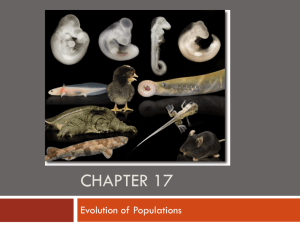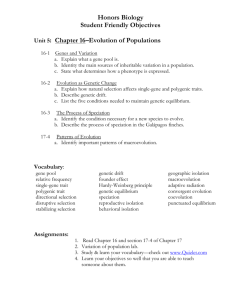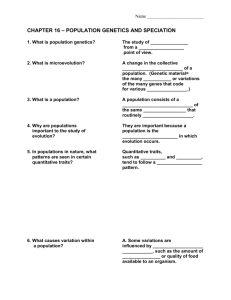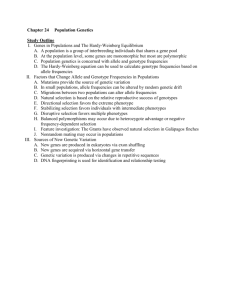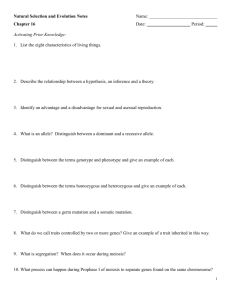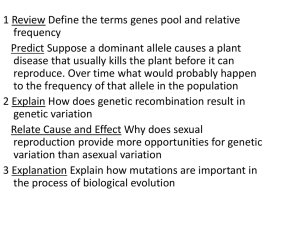Evolution of Populations
advertisement
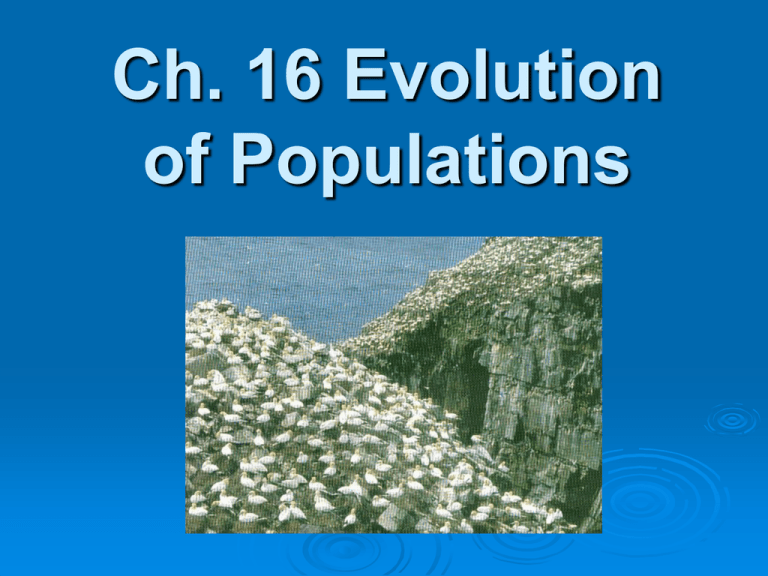
Ch. 16 Evolution of Populations Variations and Gene Pools pool – consists of all genes, including all the different alleles, that are present in a population. Gene frequency – the number of times that the allele occurs in a gene pool, compared with the number of times other alleles for the same gene occur. Relative Variations and Gene Pools Sources of Genetic Variation The 2 main sources of genetic variation are mutations & the genetic shuffling that results from sexual reproduction. Single-Gene & Polygenic Traits The # of phenotypes produced for a given trait depend on how many genes control the trait. Single-gene trait - controlled by a single gene, that has 2 alleles Ex.) Widow’s Peak Single-Gene & Polygenic Traits Polygenic traits - trait controlled by 2 or more genes Ex.) Height in humans Evolution as Genetic Change Evolutionary fitness can be viewed as an organism’s success in passing genes to the next generation. Evolutionary adaptation can be viewed as any genetically controlled trait that increases an individual’s ability to pass along its genes. Evolution as Genetic Change NS never acts directly on genes. NS can only affect which individuals survive & reproduce, & which do not. Also, remember that it is populations, not individual organisms, that can evolve over time. NS on Single-Gene Traits NS on single-gene traits can lead to changes in allele frequencies & thus to evolution. NS on Polygenic Traits NS can affect the distributions of phenotypes in any of 3 ways: -directional selection -stabilizing selection -disruptive selection NS on Polygenic Traits Directional Selection - occurs when individuals at 1 end of the curve have higher fitness than individuals in the middle or at the other end. NS on Polygenic Traits Stabilizing selection - occurs when individuals near the center of a curve have higher fitness than individuals at either end. NS on Polygenic Traits Disruptive selection - when individuals at the upper & lower ends of the curve have higher fitness than individuals near the middle. Genetic Drift drift – random change in allele frequencies that occurs in small populations. Founder effect - situation in which allele frequencies change as a result of the migration of a small subgroup of a population. Genetic Genetic Drift Evolution vs. Genetic Equilibrium Hardy-Weinberg Principle-allele frequencies in a population will remain constant unless one or more factors cause those frequencies to change. Genetic equilibrium - when allele frequencies remain constant, the population will not evolve. Evolution vs. Genetic Equilibrium 5 conditions are required to maintain genetic equilibrium: -random mating -large population -no movement into/out of pop. -no mutations -no NS Overuse of Antibiotics People may be overusing antibiotics. Doctors may prescribe them for diseases which they are not effective. This wide use of antibiotics has caused many bacteria to evolve resistance to antibiotics. The Process of Speciation Speciation - formation of a new species The gene pools of 2 populations must become separated for them to become new species. Isolating Mechanisms As new species evolve, populations become reproductively isolated from each other. Reproductive isolation - when members of 2 populations can’t interbreed & produce fertile offspring Isolating Mechanisms Behavioral isolation - when 2 populations are capable of interbreeding but have differences in courtship rituals or other reproductive strategies that involve behavior Ex.) Birds with mating songs different Isolating Mechanisms Geographic isolation - 2 populations are separated by geographic barriers like rivers, mountains, or bodies of water Ex.) Squirrels split by Colorado River Isolating Mechanisms Temporal isolation - when 2 or more species reproduce at different times Ex.) Orchids releasing pollen on different days Testing NS in Nature Speciation in Darwin’s Finches Speciation in the Galapagos finches occurred by: founding a new population geographic isolation changes in the new population’s gene pool reproductive isolation ecological competition Patterns of Evolution Macroevolution - large-scale evolutionary patterns & processes that occur over long periods of time 6 important topics in macroevolution are: • • • • • • extinction adaptive radiation convergent evolution coevolution, punctuated equilibrium, changes in developmental genes Patterns of Evolution Extinction: More than 99% of all species are now extinct It usually happens for a reason; species compete for resources, & environments change Some species adapt & survive, others become extinct Patterns of Evolution Adaptive radiation - when a single species has evolved, through NS, into diverse forms that live in different ways Ex.) Darwin’s Finches Patterns of Evolution Convergent evolution - when unrelated organisms begin to resemble one another It has occurred in both plants animals Ex.) Swimming animals & Patterns of Evolution Coevolution - when 2 species evolve in response to changes in each other over time Ex.) Orchid has long spur with nectar in its tip, a Hawk moth has equally long feeding tube that allows it to feed on the nectar Patterns of Evolution Punctuated equilibrium - a pattern of long, stable periods interrupted by brief periods of more rapid change

